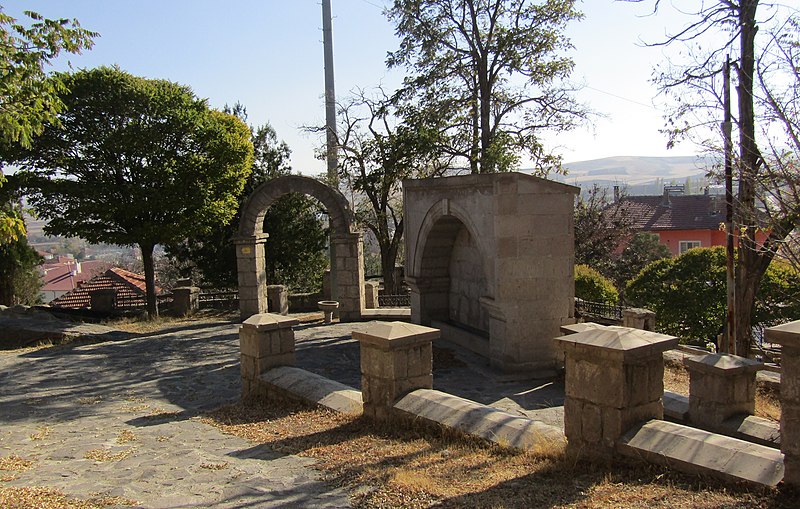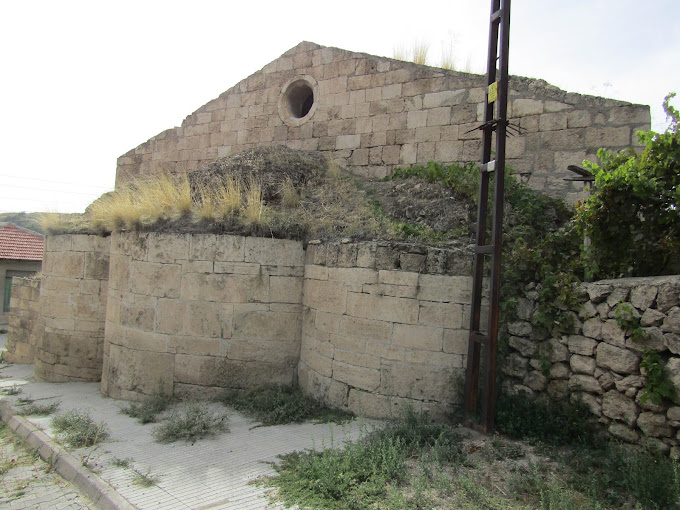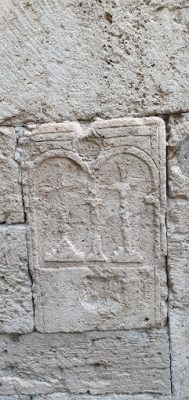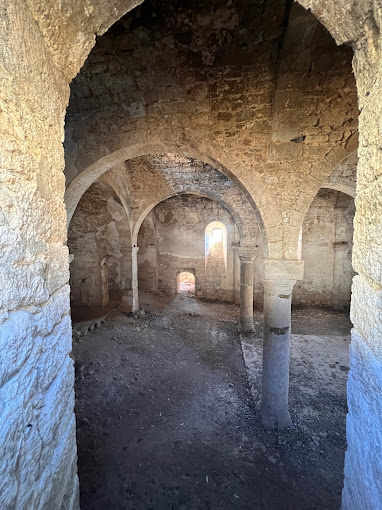Toponym
The kaza’s administrative seat, the village of Şehirkışka (renamed Şarkışla in 1928) was populated since Roman times, when it was known as Lanadara (Marandara). A historical high castle still exists in the center of the town.
Other names of the Şarkışla kaza are: Tenos, Tonos, Tonra, Tonuz, Shargishla, Sharkshla
Population
The total population of the kaza before the First World War was 40,000. Its main occupations were cattle breeding, agriculture, gardening, crafts and trade.
After the kaza Sivas, the agricultural kaza Şarkışla, traversed by the river Halys (Trk.: Kızılırmak) had the largest Armenian population in the Sivas sancak: In 1914, there lived 21,063 Armenians in 26 Armenian localities, a quarter of them—5,212 Armenians—in the town/village of Gemerek. The kaza boasted some 20 Armenian churches and 21 schools with a total enrolment of 1,988.[1]
Some Armenian settlements in the kaza:
Alakilise, Akchakale, Bavroz (Pavroz), Bardin, Burhan, Gazi-Maghara, Dandil (Tentil), Temejik (Temecik), Tekmen, Tonus, Topaj (Iskyan-Topac), Lisanli, Kayapunar, Kantaros, Karagöl, Karahisar, Kemerek, Kiki, Kurtyukaya, Maghara, Yapaltun, Chat, Çepni, Sar oghlan, Sevghen (Սըվղըն), Sikant, Pashagyugh.(2)
Destruction
“The kaymakam, Cemil Bey, who served from 8 May 1914 to September 1915, first organized the arrest of 400 villagers in the environs of Şarkışla, who were killed there night after night in groups of twenty. The deportation took place early in July. In Kangal, one of the first convoys was combined with a caravan from Sivas, forming a group of 5,000 Armenians. This convoy then followed the usual route, passing through Alacahan, where the men were removed and liquidated, and Kötü Han, where Emirpaşaoğlu Hamid Bey’s çetes were waiting for them. There, 2,000 men from Sivas and the environs of Şarkışla were seized, tied up, and brought before Hamid, who knew most of them from Sivas and thus how much each of them possessed. He managed to extract seven bags of gold from them before dispatching convoys toward Hasançelebi, Hekimhan, Hasanbadrig, Kırk Göz, and Fırıncilar. Almost all were eliminated during these stages of their trek; none reached Samsat.
Gemerek, which together with the surrounding villages formed a dense group of Armenians, was given separate treatment. Its müdir, Çerkez [Circassian] Yusuf Efendi, called on his Çerkez compatriots from Yayla (in the kaza of Aziziye) for help in slaying the men of Gemerek, Çisanlu, and Karapunar. A few notables from Gemerek were even publicly hanged, after which the women and children were put on the road to Kangal, joining the flood of deportees from Sivas and regions to the north. (…)”[3]
On 1 April 1916, the director of the Home for the Blind in Malatya, Ernst Jacob Christoffel, wrote from Sivas to the German Consul General in Constantinople, Mordtmann: „(…) You can no longer hear an Armenian sound anywhere. Thousands were killed in Gemerek.”[4]
Failed Resistance
“Approximately 3,000 Armenians from the villages of Shepni, Dendel, Burhan, and Tekmen took refuge in a huge cave in the highlands around Ak Dağ, where they fought off some 2,000 regular soldiers backed up by irregulars for several days. Some 15 men survived the massacre that followed the fighting. The women and children were deported.”[5]
Գեմերեկ – Gemerek / Kemerek
The town is situated 3 km south of the Halys (Kızılırmak) River on the road to Kayseri (Caesarea). It was one of the main settlements of the kaza. There were more than 30 destroyed villages in the vicinity of the village, which were once inhabited by Armenians.

Toponym
Presumably the toponym Gemerek derives from the Armenian ethnonym Gamirk (on behalf of the Cimmerians).
According to the ‘Index Anatolicus’, i.e. Sevan Nışanyan, however, the origin of the name is obscure; in 1522 the place name was mentioned as ‘Gamrak’ (‘Little Kayseri’ or Cappadocia). Garmir/Karmir (‘red’) in Armenian is the name of the country of Cappadocia, the center of which is Kayseri. Garmrag/Karmrag subsequently means ‘Little Cappadocia’.[6]
History
The town of Gemerek was founded by 20 Armenian families from Cilicia in the early 16th century. It is built between two hills, in a wide valley, near an old arched spring, from which the less common Kamarak version originated. The Khndzor mountains stretch to the south of Gemerek. It had seven neighborhoods, which were divided into two parts.
The Armenian-Apostolic Church of the Holy Mother of God (Surb Astvatsatsin) was a magnificent building made of stone and lime. A huge stone bell tower rested on its large columned courtyard. 200 male students studied in the Aramyan-Lusinyan schools; in addition, there were two girls’ schools and a co-educational school.
Population
In the late 19th century, Gemerek had a two-thirds Armenian population.[7]
In 1914, Gemerek had 1,400 households, more than 900 of whom were Armenians, and the rest were Turks, some of whom spoke Armenian. Most of the Armenians derived from Harput, Kyurin, Hadj(i)n and other regions of Cilicia and spoke the dialect of Kayseri. The Armenians of Gemerek were engaged in crafts and trade, reputed as skilled carpet weavers, weavers, painters and tanners.
Destruction
At the beginning of the 19th century and in 1895-1896 the Armenians of the
settlement showed stubborn resistance to the Ottoman massacres. In 1915, Armenians from 9 nearby villages took refuge in the town. During the 1915 genocide, the Armenian men of the settlement were massacred in the nearby valley called Şeytan Dere.
The two Red Cross nurses Thora von Wedel-Jarlsberg and Eva Elvers reported on Gemerek on 28 June 1915: “(…) after the men had all left, the older women were given permission to go wherever they wanted. But 30 of the prettiest young women and girls were rounded up and told, ‘Either you become Muslim or you die.’ ‘Then we die’, was the bold response. A telegram was then sent to the Vali in Sivas, who instructed that the brave young women, many of whom had been educated in American schools, be distributed to Muslims.”[8]
Very few survivors moved to Eastern Armenia, settling in Yerevan (Zeytun district) and elsewhere. Special survivors were resettled in Gemerek, where in 1946 there were 40 houses (245 people).

Elmon HANÇER: A CULTURAL HERITAGE IN ÇEPNİ TOWN OF GEMEREK PROVINCE:
SURB SARGIS ARMENIAN APOSTOLIC CHURCH

“Armenians, one of the indigenous peoples of Anatolia, called the region in Cappadocia from Kayseri toSivas and from the Kızılırmak River to the Tohma Stream in the south, Kamirk until the mid-20th century, and a settlement in the Kayseri-Sivasar region was called Kamirk or Kamrag. They lived in this town, which was renamed Gemerek during the Ottoman period, until the 1970s. Today, the Surp Sarkis Armenian Church in the Çepni Town of Gemerek, a district of Sivas, is a cultural asset owned by the Çepni Municipality. The Surp Sarkis Church, which is still the only Christian religious architecture in and around Gemerek, was rebuilt in the 19th century. From the early 20th century onwards, the church, which became derelict with the departure of the Çepni Armenians, lost its original function, but was not converted into a mosque. Except for some interventions during the restoration in the 1950s, no changes were made in the spatial context. In recent years, the development of cultural awareness has brought to the agenda the restoration of Surp Sarkis Church, which remains alive in the memory of the Çepni people, and giving it a new function. Restoration work was carried out in cooperation with Erciyes University Faculty of Architecture and the Association for the Protection of Cultural Heritage. The church is included in the scientific literature for the first time in detail in the context of art history with this study.The church is built entirely of cut stone and has a three-nave basilical and cruciform plan scheme. This church, which was preserved on a large scale in a rural area until the 21st century, draws attention with its architecture that reflects the care of the buildings in rich urban areas such as Istanbul, Sivrihisar and Kayseri despite its small scale.”
Quoted from: https://search.trdizin.gov.tr/tr/yayin/detay/305546/gemerek-ilcesi-cepni-beldesinde-kulturel-bir-miras-surp-sarkis-ermeni-apostolik-kilisesi
